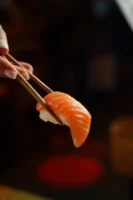
Imagine a place where steaming bowls of ramen, crispy tempura, and cold beers are not the enemy of a healthy weight, but a regular part of life.
While the rest of the world cycles through restrictive diets, Japan maintains one of the lowest obesity rates on the planet, all while enjoying some of the most delicious food imaginable.
So, what’s their secret?
Forget everything you think you know about tiny portions—their power lies in a set of unspoken, forbidden food rules deeply woven into the culture.
By the end of this article, you’ll understand the specific, lesser-known principles that guide Japanese eating habits and how you can steal these strategies to enjoy your favorite foods without guilt.
This isn’t about deprivation; it’s about a smarter, more joyful way to eat.
The Art of the First Bite: Hara Hachi Bu

Before the first piece of sushi even touches the plate, the Japanese mindset is already set for mindful consumption.
The most famous guiding principle is Hara Hachi Bu, an ancient Confucian teaching that instructs people to eat until they are 80% full.
This isn’t about counting calories or measuring macros; it’s about cultivating a deep sense of bodily awareness.
How do they actually do it?
They eat slowly, savoring each bite, and pause frequently to check in with their stomach.
It takes about 20 minutes for your brain to register that your stomach is full, so by eating at a leisurely pace, you naturally avoid the overstuffed, sluggish feeling that comes from rushing through a meal.
This single rule transforms eating from a race to a mindful experience, allowing you to enjoy a rich bowl of ramen completely, yet stop before you feel uncomfortable.
The Strategic Order of Operations on Your Plate

Here’s a rule you can apply at your very next meal: order matters.
A traditional Japanese meal, even a simple one, is rarely just one heaping portion of a single food.
It’s a composition, often served in several small bowls and plates.
The strategic sequence often begins with soup, like a light miso, or a small vegetable-based dish.
This immediately starts to activate digestion and provides a bit of bulk and nutrients, taking the edge off your hunger.
Then, you move on to the main event—the protein and carbohydrates.
By the time you get to that glorious pile of noodles or that crispy piece of fried chicken, you’re already partially satisfied and less likely to devour it mindlessly.
This is how one can enjoy ramen and beer: the meal isn’t just ramen and beer.
It might be accompanied by a small side of greens, and the eating pace is slow enough to truly appreciate the complex flavors, signaling fullness long before the bowl is empty.
Food as Culture, Not Just Fuel

In many Western cultures, food is often viewed as either fuel or a guilty pleasure.
In Japan, food is deeply respected as an integral part of culture, seasonality, and art.
This philosophical shift is everything.
Meals are presented beautifully, with attention to color, texture, and balance.
This isn’t just for Instagram; it’s because eating is considered a sensory experience to be appreciated fully.
When you sit down to a meal that is artfully arranged, you’re instinctively prompted to eat more slowly and mindfully.
You notice the crunch of the fresh vegetable, the umami depth of the broth, the perfect chew of the noodle.
This practice of mindful eating means you derive more satisfaction from less food.
There’s no concept of “cheat days” because no food is inherently bad.
Instead, there’s a focus on overall balance and the pure enjoyment of high-quality, delicious food without the accompanying guilt.
How to Steal These Rules for Yourself

You don’t need to move to Tokyo or start eating sushi for breakfast to apply these principles.
The beauty of these forbidden rules is their adaptability.
Start by simply slowing down.
Put your fork down between bites, engage in conversation, and truly taste your food.
Try the 80% rule: when you feel you could eat more, but aren’t necessarily hungry anymore, just stop.
Save the rest for later.
Recompose your plate: before diving into your main course, have a small salad, a cup of broth-based soup, or some vegetables.
This simple act of front-loading with fiber-rich foods will change your entire eating experience.
Most importantly, shift your mindset.
See your next meal not as a task, but as a valuable, enjoyable pause in your day.
Appreciate the flavors, the company, and the moment.
The secret to staying thin in Japan isn’t a mysterious gene or a life of denial.
It’s a collection of thoughtful habits that create a harmonious relationship with food.
They have mastered the art of indulgence through mindfulness, balance, and profound respect for what’s on their plate.
So, the next time you sit down for a meal you love, ask yourself: are you just eating, or are you dining?
The difference between the two might just be the most powerful health hack you ever learn.
The Simple Tool That Masters Balance

So, how do you put ‘Hara Hachi Bu’ into practice without constantly guessing?.
Imagine you’re about to dive into a glorious bowl of ramen, complete with a soft-boiled egg and two slices of chashu pork.
Your stomach might say ‘more,’ but the principle asks for ‘just enough.’.
This is where a humble Kitchen Scale transforms from a simple gadget into your secret weapon for mindfulness.
Think of it not as a restrictive diet tool, but as a guide to culinary liberation.
Instead of denying yourself the rich toppings, you measure them.
You discover that 30 grams of pork and one perfect egg deliver immense satisfaction without the sluggishness that follows a feast.
It’s about precision leading to pleasure, not deprivation.
For a tool that blends accuracy with simplicity, many find the Etekcity Food Kitchen Scale incredibly user-friendly.
Its sleek design makes it a permanent fixture on the counter, a constant reminder to eat with intention.
You can even measure the perfect 12 ounces for a crisp, refreshing beer to accompany your meal.
This small act of weighing connects you directly to the moment, turning a meal into a practice of awareness.
You enjoy every single bite, fully present, and finish feeling perfectly content—not stuffed.
That, right there, is the secret to unlocking a trim waistline without ever feeling like you’re missing out.

Leave a Reply